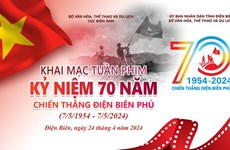Local cuisine promotion has a long Hue to go: residents
Hue is best known for elegant royal cuisine. But there is far more to
the former imperial city's food culture than what was served to the
Nguyen dynasty in the 1800s.
Hue is best known for elegant royal cuisine. But there is far more to
the former imperial city's food culture than what was served to the
Nguyen dynasty in the 1800s.
Food plays a key role in Hue life. The first skill that a girl learns from her mother is cooking, which allows recipes to be preserved for generations.
One distinctive quality of Hue food is the harmonisation of yin and yang in each dish. For example, molluscs are always cooked with chilli, pepper, lemongrass and grapefruit leaves, "hot" spices that balance the "cool" features of the water-based creatures.
Various snack-like items, such as banh beo, banh nam, banh loc, banh canh and che, are a major part of the cuisine. Visitors can find these items at Hue restaurants in Hanoi and Ho Chi Minh City. Bun bo Hue, a local breakfast dish, is also popular around the country.
Recently, Vietnam's record book listed several Hue dishes on its list of the country's best foods: bun bo (beef noodles), com hen (rice with mussels), banh beo (rice cake with grilled shrimp), banh bot loc (dumplings with shrimp), banh khoai (fried rice crepes), ruoc (shrimp paste), me xung (sesame candy), che hat sen (sweet lotus seed pudding), tom chua (pickled shrimp), and thanh tra (a grapefruit variety that was served to the king).
However, Hue residents pay little attention to the recognition, objecting that the value of Hue cuisine is greater than what the book listed. Che hat sen, for instance, is not considered the most outstanding among the various kinds of che that Hue people cook. Many blame the failure to promote authentic food to the list makers.
Introducing the cuisine to tourists is also a problem. The city does not have many sit-down restaurants selling quality Hue food. Some dishes are best prepared by vendors, but foreigners do not always trust them when it comes to hygiene.-VNA
Food plays a key role in Hue life. The first skill that a girl learns from her mother is cooking, which allows recipes to be preserved for generations.
One distinctive quality of Hue food is the harmonisation of yin and yang in each dish. For example, molluscs are always cooked with chilli, pepper, lemongrass and grapefruit leaves, "hot" spices that balance the "cool" features of the water-based creatures.
Various snack-like items, such as banh beo, banh nam, banh loc, banh canh and che, are a major part of the cuisine. Visitors can find these items at Hue restaurants in Hanoi and Ho Chi Minh City. Bun bo Hue, a local breakfast dish, is also popular around the country.
Recently, Vietnam's record book listed several Hue dishes on its list of the country's best foods: bun bo (beef noodles), com hen (rice with mussels), banh beo (rice cake with grilled shrimp), banh bot loc (dumplings with shrimp), banh khoai (fried rice crepes), ruoc (shrimp paste), me xung (sesame candy), che hat sen (sweet lotus seed pudding), tom chua (pickled shrimp), and thanh tra (a grapefruit variety that was served to the king).
However, Hue residents pay little attention to the recognition, objecting that the value of Hue cuisine is greater than what the book listed. Che hat sen, for instance, is not considered the most outstanding among the various kinds of che that Hue people cook. Many blame the failure to promote authentic food to the list makers.
Introducing the cuisine to tourists is also a problem. The city does not have many sit-down restaurants selling quality Hue food. Some dishes are best prepared by vendors, but foreigners do not always trust them when it comes to hygiene.-VNA













